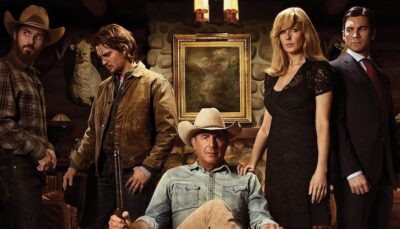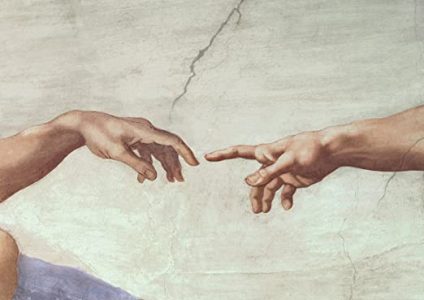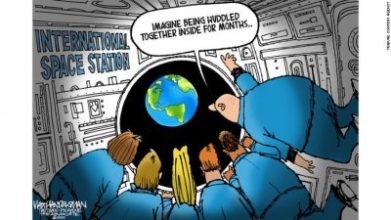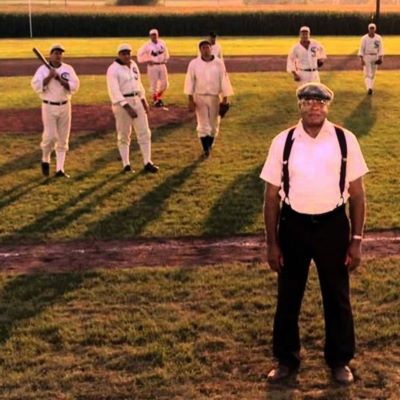
Ray, people will come, Ray.
They’ll come to Iowa for reasons they can’t even fathom. They’ll turn up your driveway, not knowing for sure why they’re doing it. They’ll arrive at your door as innocent as children, longing for the past.
“Of course, we won’t mind if you look around,” you’ll say. “It’s only twenty dollars per person.” They’ll pass over the money without even thinking about it. For it is money they have and peace they lack.
And they’ll walk out to the bleachers, and sit in shirt-sleeves on a perfect afternoon. They’ll find they have reserved seats somewhere along one of the baselines, where they sat when they were children and cheered their heroes. And they’ll watch the game, and it’ll be as if they’d dipped themselves in magic waters. The memories will be so thick, they’ll have to brush them away from their faces.
People will come, Ray.
The one constant through all the years, Ray, has been baseball.
America has rolled by like an army of steamrollers. It’s been erased like a blackboard, rebuilt, and erased again. But baseball has marked the time.
This field, this game — it’s a part of our past, Ray. It reminds us of all that once was good, and it could be again.
Ohhhhhhhh, people will come, Ray. People will most definitely come.
James Earl Jones, Field of Dreams
These stirring words from the iconic mythological Field of Dreams have loomed large in the minds of baseball fans ever since they were first spoken. They were spoken by James Earl Jones at a moment of cosmic truth in the movie. They were spoken when Kevin Costner had to make a decision between myth and reality. They were spoken between a team led by the long-deceased Shoeless Joe Jackson and a foreclosure notice on his home, another symbol of the American Dream.
Spoiler alert. Kevin Costner chose myth over reality leading to another and briefer iconic line from the movie.
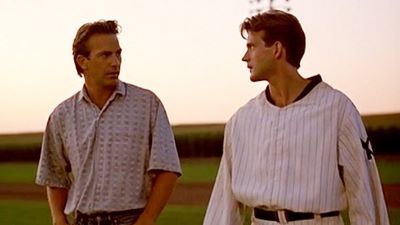
“Hey Dad. Do you want to have a catch?”
This one line has been known to make grown men cry. There on the field of dreams a father and son have a catch. The fact that the father is dead lo these many years adds to its power. Here he appears in the prime of life with his son, daughter-in-law, and granddaughter not even a gleam in his eye. He thinks he is in heaven only to learn that it is Iowa. As the lights from the house are turned on, the father and son have a catch and suddenly out of nowhere, cars are lining up to be part of the field of dreams.
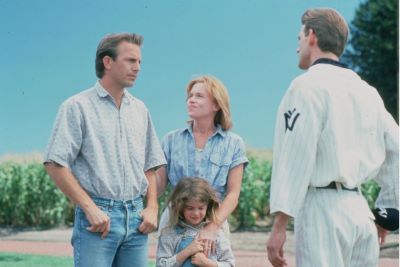
The American Dream
Pure magic. Difficult to do in a movie, even harder to do in real life.
THE NATURAL WITH ROBERT REDFORD

Another mythical moment occurs with Roy Hobbs. In this instance the injured Hobbs is a bat with everything on the line. You can see the blood through his shirt. After a long fly-ball, Wonder Boy, his mythical bat that he had carved from a tree struck by lightning is splintered and unusable. The bat boy who has been working on making his own bat brings it to Hobbs.
Spoiler alert: Hobbs then hits a home run not only to win the games but to defeat the forces of darkness which had threatened it. The home-run ball shatters the nightlights in stadium. It sails off into the cosmos. Finally it lands in the mitts of a father and son having a catch.
Pure magic. Difficult to do in a movie, even harder to do in real life.
KIRK GIBSON
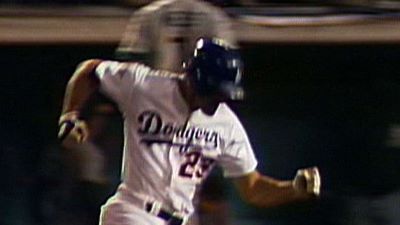
Sometimes reality mimics myth. In the real world, in the opening game of the 1988 World Series between the Los Angeles Dodgers and the Oakland Athletics, the moment of truth has arrived. It really is the 9th inning. The Dodgers really are down to their last at bat. Then from out of the dugout comes their leader. He is a physically beaten player unable to play an entire game. In the words of Dodger broadcaster Vin Scully, Dodger manager Tommy Lasorda had decided to roll the dice. He sends Gibson up to bat against the ace relief pitcher and future Hall-of-Famer Dennis Eckersley. It seemed like a mismatch.
Spoiler alert: Gibson hits a game-winning home run. He circles the bases pumping his arms in physical exuberance as his teammates rush out to greet him. The A’s never recover. They had their best on the mound and the game seemingly won when suddenly they became part of an iconic moment in baseball history but on the wrong side.
Pure magic. Difficult to do in a movie, even harder to do in real life.
GIBSON AND HOBBS
Somewhere between the first and second games of the 1988 World Series, someone at NBC had the insight to combine these two home runs in a single clip, the mythical one of Hobbs and the actual one of Gibson.. Scenes of the home run and his circling the bases to be greeted by his teammates were interwoven with scenes of the Gibson home run and his circling the bases to be greeted by his teammates.
Pure magic. Difficult to do in a movie, even harder to do in real life.
FREDDIE FREEMAN, KIRK GIBSON, AND ROY HOBBS

Now we have another home run to add to the mythic list. The World Series is between not just any two teams but the Yankees and the Dodgers. Together these storied teams have played against each other 12 times in the World Series. Many of the great moments that have become part of baseball history are from these World Series conflicts.
So here we are. Bottom of the tenth. Two outs, Bases loaded. How many times have kids imagined that scenario? Freeman has been injured. He was not shot like Hobbs or simply beaten down like Gibson. He was able to play the entire game and even had hit a triple earlier. Now he was at bat with everything on the line against the Yankees, a fabled team of 27 World Series wins.
Spoiler alert: Freeman hits the first walk-off grand slam home run in World Series baseball history after 692 games. And to add icing to the cake, he hits another home run in Game 2. And then another one in Game 3.
Immediately people begin comparing the Freeman home run to the Gibson home run. But let’s not forget Roy Hobbs and the mythic field of dreams either.
There is more to the game-winning home run in the World Series. There is the father-son story as well as to the hitter’s family. After the home run celebration on the field, Freddie Freeman found father Fred Freeman in the stands behind home plate. Then a family celebration ensued. The father stills throw batting practice to the son just as he did when they were younger.
He’s been there since I was a little boy, throwing batting practice to me every day. This isn’t my moment. That’s my dad’s moment.
But the parallels between the homers [of Gibson and Freeman], right down to their respective landing spots in the right field stands and time 8:37 PM, indeed provide an echo of history, the kind baseball offers like no other sport. (Ken Rosenthal, “For Freddie Freeman, his family and Dodgers fans, a grand moment on the biggest stage,” NYT October 26, 2024).
When you get told you do something like that, in this game that’s been around a very long time — I love the history of this game. To be a part of it, it’s special. (Jayson Stark, “Freddie Freeman wallops his way into World Series history with walk-off slam that’ll float forever” NYT October 26, 2024).

So here we are in this extremely tight presidential election year and no one has reached out to the Field of Dreams fans.
A new chapter is added in the Home Run Derby during the 2025 All Star game. The Major League home run leader and the winner of the Home Run Derby is pitched to by his father while his brother catches.



